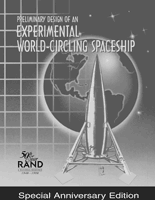
Preliminary Design of an Experimental World-Circling Spaceship
Download
Download eBook for Free
Part 1
Chapters 1-8
| Format | File Size | Notes |
|---|---|---|
| PDF file | 5.1 MB | Use Adobe Acrobat Reader version 10 or higher for the best experience. |
Part 2
Chapters 9-15
| Format | File Size | Notes |
|---|---|---|
| PDF file | 5.6 MB | Use Adobe Acrobat Reader version 10 or higher for the best experience. |
Part 3
Chapters 16-17, Appendices A-H
| Format | File Size | Notes |
|---|---|---|
| PDF file | 5.9 MB | Use Adobe Acrobat Reader version 10 or higher for the best experience. |
Purchase
Purchase Print Copy
| Format | List Price | Price | |
|---|---|---|---|
| Add to Cart | Paperback328 pages | $65.00 | $52.00 20% Web Discount |
More than eleven years before the orbiting of Sputnik, history’s first artificial space satellite, Project RAND — then active within Douglas Aircraft Company’s Engineering Division — released its first report: Preliminary Design of an Experimental World-Circling Spaceship (SM-11827), May 2, 1946. Interest in the feasibility of space satellites had surfaced somewhat earlier in a Navy proposal for an interservice space program (March 1946). Major General Curtis E. LeMay, then Deputy Chief of the Air Staff for Research and Development, considered space operations to be an extension of air operations. He tasked Project RAND to undertake a feasibility study of its own with a three-week deadline. The resulting report arrived two days before a critical review of the subject with the Navy. The central argument turns on the feasibility of such a space vehicle from an engineering standpoint, but alongside the curves and tabulations are visionary statements, such as that by Louis Ridenour on the significance of satellites to man’s store of knowledge, and that of Francis Clauser on the possibility of man in space. But the most riveting observation, one that deserves an honored place in the Central Premonitions Registry, was made by one of the contributors, Jimmy Lipp (head of Project RAND’s Missile Division), in a follow-on paper nine months later: “Since mastery of the elements is a reliable index of material progress, the nation which first makes significant achievements in space travel will be acknowledged as the world leader in both military and scientific techniques. To visualize the impact on the world, one can imagine the consternation and admiration that would be felt here if the United States were to discover suddenly that some other nation had already put up a successful satellite.”
Table of Contents
Part 1
Chapter One
Introduction
Chapter Two
Significance of a Satellite Vehicle
Chapter Three
General Characteristics of a Satellite Vehicle
Chapter Four
Power Plant Suitable for Satellite Vehicles
Chapter Five
Dynamics of Achieving Orbital Motion
Chapter Six
Rocket Power Plants and Fuels
Chapter Seven
Consideration of Structural Weight
Chapter Eight
Investigation of Design Proportions
Part 2
Chapter Nine
Final Establishment of Sizes and Trajectories
Chapter Ten
Method of Guiding Vehicle on Trajectory
Chapter Eleven
Problems After Orbit is Established
Chapter Twelve
The Problem of Descent and Landing
Chapter Thirteen
Description of Vehicle
Chapter Fourteen
Possibilities of a Man Carrying Vehicle
Chapter Fifteen
Estimation of Tine and Cost of Project
Part 3
Chapter Sixteen
Research and Development Necessary for Design
Chapter Seventeen
Conclusion
Appendix A
The Upper Atmosphere
Appendix B
The Determination of the Drag Coefficient
Appendix C
Lagrangian Equations
Appendix D
Sample of the Detailed Trajectory Calculation
Appendix E
Development of Small Perturbation Equations of Motion
Appendix F
Orbit Calculation
Appendix G
The Meteorite-Hit Probability Formulas
Appendix H
Development of Stability Equations
This report is part of the RAND Corporation Special memorandum series. The Special Memorandum was a product of the RAND Corporation from 1947 to 1973 that represented working papers meant to report specialized results of RAND research to appropriate audiences.
This document and trademark(s) contained herein are protected by law. This representation of RAND intellectual property is provided for noncommercial use only. Unauthorized posting of this publication online is prohibited; linking directly to this product page is encouraged. Permission is required from RAND to reproduce, or reuse in another form, any of its research documents for commercial purposes. For information on reprint and reuse permissions, please visit www.rand.org/pubs/permissions.
The RAND Corporation is a nonprofit institution that helps improve policy and decisionmaking through research and analysis. RAND's publications do not necessarily reflect the opinions of its research clients and sponsors.